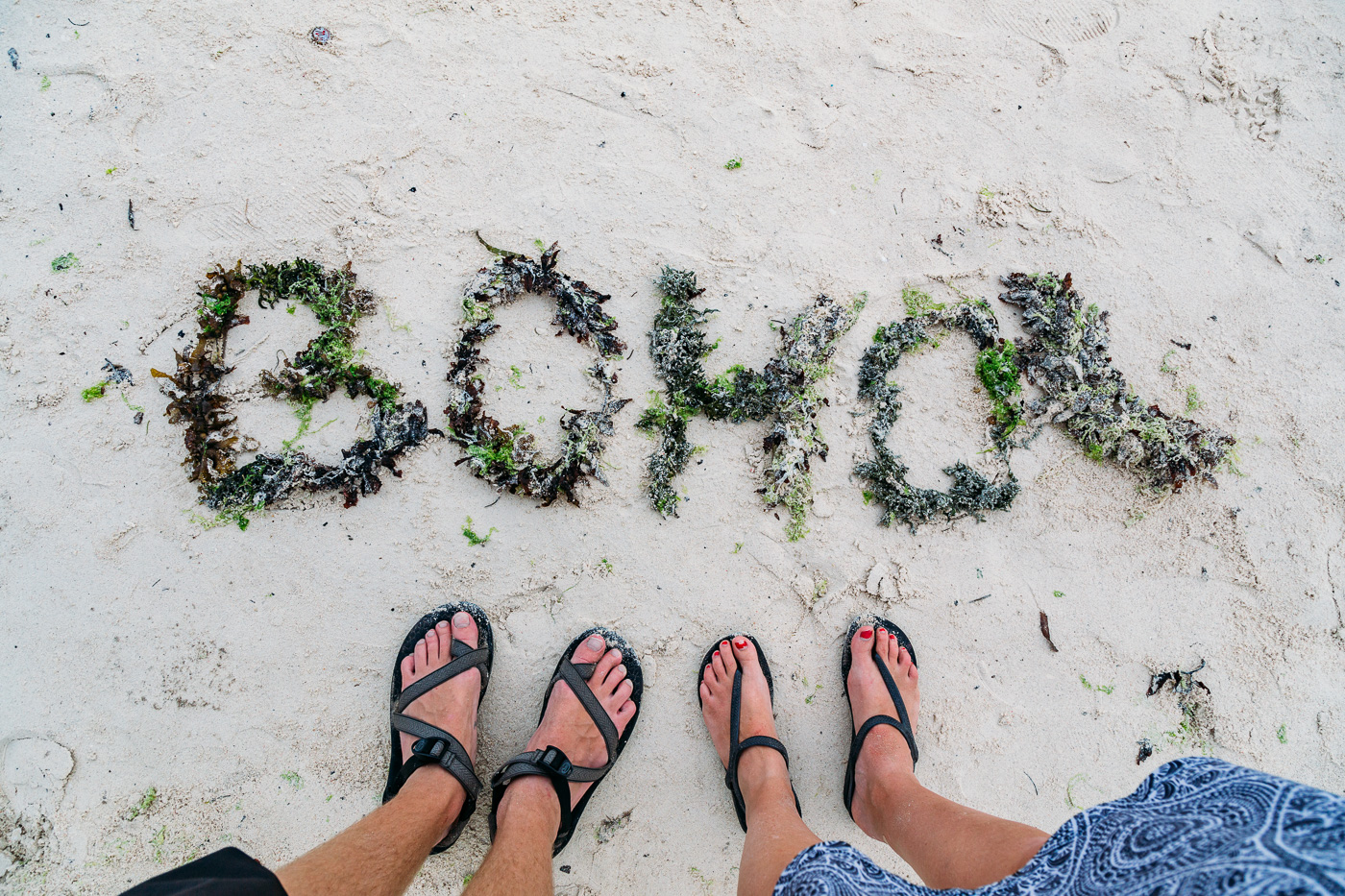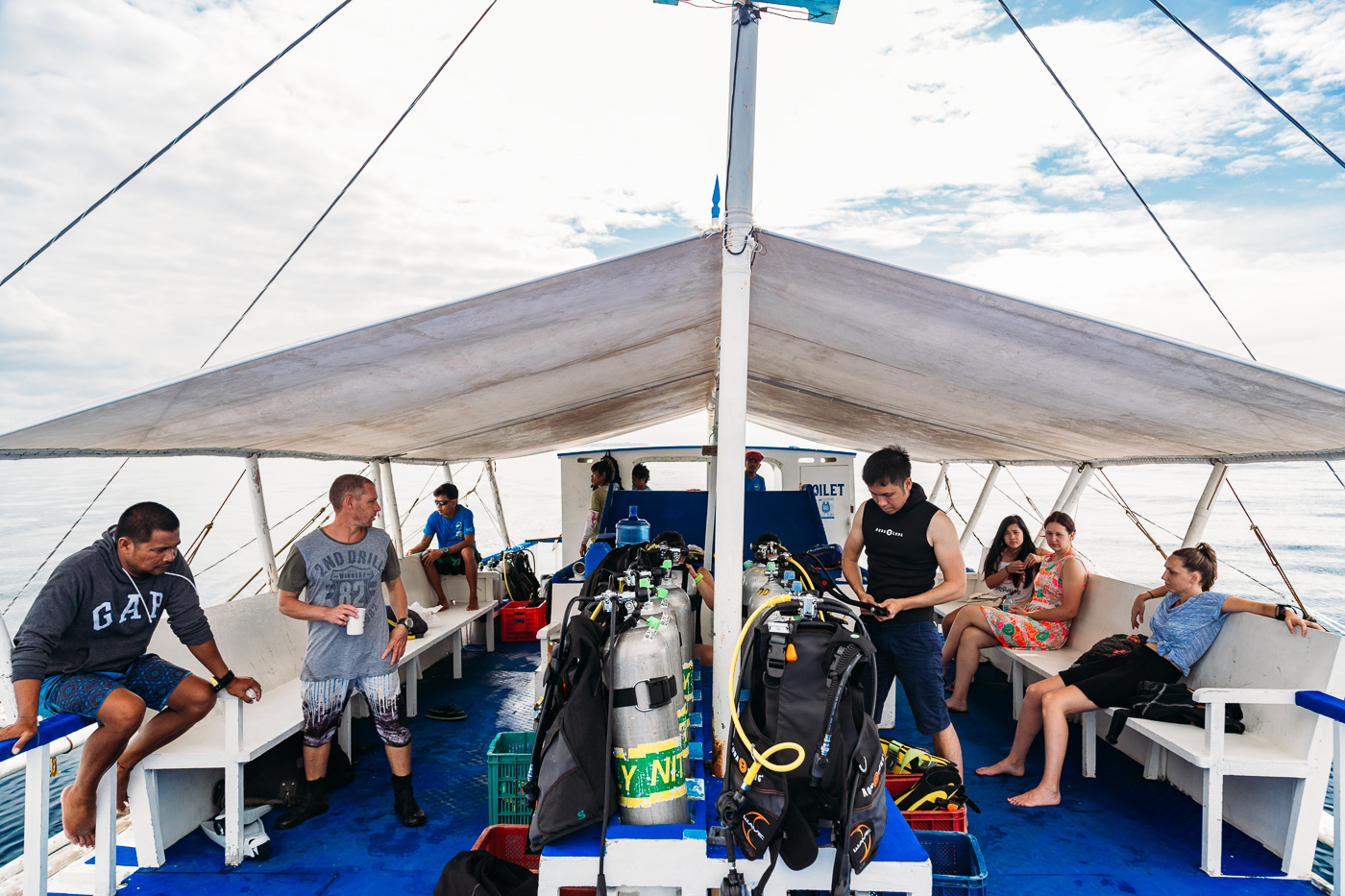Are you considering pursing advanced scuba diving certifications in the Philippines? If not, you should be. With how much we fell in love with scuba diving in Thailand, Indonesia and the Philippines, we knew we wanted to take our diving to the next level with the PADI Advanced Open Water Diver Certification. The advanced course isn’t difficult and there is no written test, which we liked. The two- to three- day course consists of five adventure dives each with a bit of reading and a few underwater skills to complete. But mostly this was just good diving fun. So here’s what our experience pursing Advanced Open Water certification on Bohol with Sierra Madre Divers was like.
 The PADI Advanced Open Water Diver Course
The PADI Advanced Open Water Diver Course
The Advanced Open Water Diver course is the next step in the PADI and SSI diving certification ladder. It typically is pursued shortly after you complete your Open Water Diver certification, as we did on Gili Air, Indonesia several months ago.
I’ll be honest – we were resisting pursuing our AOWD cert since we were having so much fun going on free dives around Thailand, Indonesia and the Philippines. We also didn’t know if it was worth the extra investment of our time and money at this point as we felt we were perfecting our skills through other night and deep dives already.
The good news is the PADI Advanced Open Water Diver (AOWD) course is much less about coursework and a lot more about diving. In a nut shell, the AOWD course is five adventure dives. Underwater navigation and deep diving are required as two of your dives and then you have the option of choosing from the following: peak performance buoyancy, wreck diving, underwater photography, enriched air nitrox, night diving, fish identification, dry suit diving and many more like the AWARE Sea Turtle Specialty Identification. The main goal of the program is to dive, fine tune your skills and have fun. There aren’t any written tests and you can complete the program within two or three days which makes this course perfect for a shorter holiday.
The biggest benefit of completing this course during our time in Bohol, other than having fun under the sea, is that we would then be able to dive deeper (30 meters rather than the 18 meters permitted with Open Water certification) which would be required for our upcoming Coron ship wreck dives. Our AOWD certification also gave us the confidence to go on more challenging dives and the opportunity to learn a lot more about sea turtles.
 Why Bohol for Your Advanced Open Water?
Why Bohol for Your Advanced Open Water?
With how popular Koh Tao (Thailand) and the Gili Islands (Indonesia) are for pursuing cheap scuba certifications in Southeast Asia, the Philippines really wasn’t on our radar for furthering our underwater learning. We can tell you now that the Philippines is an awesome place to get Open or Advanced Open Water Certified – there is some absolutely fantastic scuba diving in here.
We chose Panglao Island, Bohol to pursue our Advanced Open Water Diver certification because it has a well-established diving community. There are plenty of dive shops to choose from along Alona Beach so it really comes down to cost and fit with the dive shop. We initially came across Sierra Madre diving school on Trip Advisor but knew this was the shop for us after emailing with the dive shop owner about their work with Project AWARE and other ocean conservation groups.
With a wide variety of dive sites and great dive schools like our friends over at Sierra Madre Divers, Bohol is the perfect place to get your Advanced Open Water certification! It will open a whole new world of possibilities to divers looking to explore the underwater world.
 Pursuing Our Advanced Open Water Diver Certification in Bohol
Pursuing Our Advanced Open Water Diver Certification in Bohol
We had two days while in Bohol to pursue our Advanced Open Water Diver course on Alona beach, Panglao Island. When we arrived to Sierra Madre Divers the evening prior to the start of our course, we met with our dive master, Bernard, and discussed options for our coursework. Underwater navigation and deep diving were both required so we discussed options for our additional three courses and made a dive plan for the next wo days.
Peak Performance Buoyancy
I was really looking forward to the Peak Performance Buoyancy dive since I have been eager to improve my control skills and use less air on my descents. So for our first dive, we went out with our dive master, Bernard, and practiced our buoyancy skills. Some of the skills we practiced included the kick stroke, knocking over weights with our mouthpiece without touching the rest of our bodies to the ground, completing somersaults forwards and backwards through controlled breathing, and hovering vertically and horizontally without moving. It really felt like more of a fun playtime than a testing of our skills. Our “coursework” in the water lasted approximately 25 minutes and then we had the remainder to go on a fun dive and enjoy the sea.
Underwater Navigation
We started to learn about good navigation even before we entered the water. Bernard equipped us with compass wristbands and discussed the fundamentals of looking at a dive site map and understanding how to use our compasses as a guide. We also discussed important features of a dive site that we need to pay close attention to, such as depth and currents. Underwater, we were asked to use kick strokes and identifying underwater markers to navigate ourselves from one point out and back. We did this several different times, using our compasses to make 90-degree and 120-degree turns to get us back to our point of origination. Once we completed our navigation we again had another 20+ minutes of free dive time to explore Alona Beach’s wall dive sites.
Night Diving
We had been on several night dives already like our amazing Moalboal night dive. There’s not a lot to learn prior to going on a night dive aside from how to communicate with your dive guide and fellow divers using your torch and hand signals under the water. That said, it can be a bit disorienting if you haven’t been on a night dive before. This adventure dive is all about testing a student’s comfort level underwater and showing them a new crop of nocturnal sealife.
Scuba diving at night with zero visibility teaches you to focus on that which you can see within the beam of your light. You also have to work to control your buoyancy since you can’t see what is around you and you have to stay much closer with your dive buddy in case your torch were to go out. Sadly our Bohol night dive off the Alona beach walls was relatively uneventful but that’s just how it goes on some dives!
Deep Diving
While night diving still occasionally gives me the chills, deep dives are a breeze. Being certified to deep dive to 30 meters is really important for certain dive sites where there are interesting features or marine life that only habituate at deeper depths. Be aware, if you are headed to dive the WW2 wrecks in Coron or to swim with thresher sharks in Malapascua, being deep dive certified is necessary.
Instructors will usually have props that they use to show you how your mental agility, air volume and colors are all impacted at greater depths. We technically already had our Adventure Deep Dive Certification from our Similan Islands liveaboard so didn’t complete any tests this time around.
On a serious note, one potential side effect of deep diving is nitrogen narcosis which effects people differently at different depths but can impair a person’s metal agility to make decisions. We generally don’t like deep dives unless there is something really interesting to see. You suck down your air much faster impacting overall dive time and the color and light are scarce which makes it difficult for underwater photography.
Nitrox
Because we were already deep dive certified, we decided to add on the PADI Enriched Air Nitrox Diver Course. As we understand it, this will soon be included as one of the options of your Advanced Open Water Diver course but at the time, we had to pay extra for this certification so best to check with the dive shop first before signing up.
Nitrox courses are very popular because diving on enriched air allows you more no decompression time, especially when you are diving regularly, thanks to the higher content of oxygen and lower content of nitrogen in the tank mixture. You also typically get more bottom time.
Now, this one did require a bit more theory and book work because on enriched air, you have to consider the impact of greater oxygen levels on your depth and be able to analyze the oxygen content in your tank.We also had to learn how to identify our max depth and set our dive computers.
After our nitrox dives, we took a short test based on the chapters we read and conversations we had about nitrox. We happily (and luckily) passed the test so now are able to dive on enriched air as well!
AWARE Sea Turtle Identification Course
By far our favorite dive during our Advanced Open Water Diver course was completing our AWARE Sea Turtle Specialty Identification. This is a unique course offered by Sierra Madre Divers in partnership with AWARE and LAMAVE so another good reason to pursue your Advanced Open Water Diver Certification on Bohol. Yes, this one required a bit of classroom learning but it was super educational and interesting. You can read all about our experiences identifying turtles here.
 If You Go: Advanced Open Water Course on Bohol
If You Go: Advanced Open Water Course on Bohol
What: Pursuing your Advanced Open Water Diver Certification is definitely a commitment of time and money so finding a location and dive shop that you are excited about is important. Panglao Island on Bohol, Philippines offers divers with range of different dive sites and access to Balicasag Island, one of the best dive sites in the Philippines.
Where: Sierra Madre Divers is located on Anda Beach, Panglao Island of Bohol in the Philippines.
When: Bohol scuba diving is best between October and May.
How: You can sign up for another number of diving certification courses on Bohol through Sierra Madre Divers. Be sure to check out their Project AWARE sea turtle identification course for something cool and different that you can’t find elsewhere.
Many thanks to Sierra Madre Divers for helping sponsor Bold Travel’s diving on Bohol. As you consider your options for Bohol scuba diving certifications reach out to Jaki at Sierra Madre Divers (+63-385029789, info@dive-bohol.com). But like always we’re keeping it real – all opinions are our own, like you could expect less from us!

















